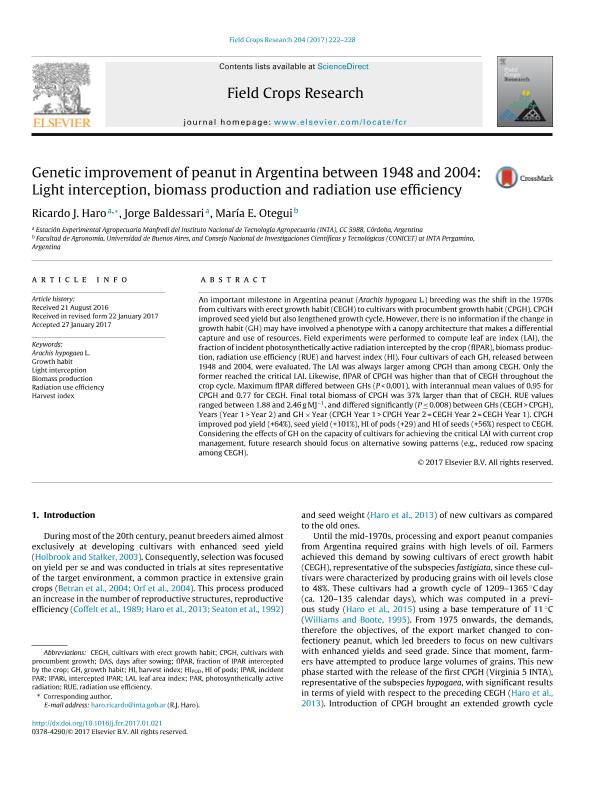Mostrar el registro sencillo del ítem
dc.contributor.author
Haro Juarez, Ricardo Javier

dc.contributor.author
Baldessari, Jorge
dc.contributor.author
Otegui, Maria Elena

dc.date.available
2019-03-29T17:54:03Z
dc.date.issued
2017-03
dc.identifier.citation
Haro Juarez, Ricardo Javier; Baldessari, Jorge; Otegui, Maria Elena; Genetic improvement of peanut in Argentina between 1948 and 2004: Light interception, biomass production and radiation use efficiency; Elsevier Science; Field Crops Research; 204; 3-2017; 222-228
dc.identifier.issn
0378-4290
dc.identifier.uri
http://hdl.handle.net/11336/72849
dc.description.abstract
An important milestone in Argentina peanut (Arachis hypogaea L.) breeding was the shift in the 1970s from cultivars with erect growth habit (CEGH) to cultivars with procumbent growth habit (CPGH). CPGH improved seed yield but also lengthened growth cycle. However, there is no information if the change in growth habit (GH) may have involved a phenotype with a canopy architecture that makes a differential capture and use of resources. Field experiments were performed to compute leaf are index (LAI), the fraction of incident photosynthetically active radiation intercepted by the crop (fIPAR), biomass production, radiation use efficiency (RUE) and harvest index (HI). Four cultivars of each GH, released between 1948 and 2004, were evaluated. The LAI was always larger among CPGH than among CEGH. Only the former reached the critical LAI. Likewise, fIPAR of CPGH was higher than that of CEGH throughout the crop cycle. Maximum fIPAR differed between GHs (P < 0.001), with interannual mean values of 0.95 for CPGH and 0.77 for CEGH. Final total biomass of CPGH was 37% larger than that of CEGH. RUE values ranged between 1.88 and 2.46 g MJ−1, and differed significantly (P ≤ 0.008) between GHs (CEGH > CPGH), Years (Year 1 > Year 2) and GH × Year (CPGH Year 1 > CPGH Year 2 = CEGH Year 2 = CEGH Year 1). CPGH improved pod yield (+64%), seed yield (+101%), HI of pods (+29) and HI of seeds (+56%) respect to CEGH. Considering the effects of GH on the capacity of cultivars for achieving the critical LAI with current crop management, future research should focus on alternative sowing patterns (e.g., reduced row spacing among CEGH).
dc.format
application/pdf
dc.language.iso
eng
dc.publisher
Elsevier Science

dc.rights
info:eu-repo/semantics/openAccess
dc.rights.uri
https://creativecommons.org/licenses/by-nc-nd/2.5/ar/
dc.subject
Arachis Hypogaea L.
dc.subject
Biomass Production
dc.subject
Growth Habit
dc.subject
Harvest Index
dc.subject
Light Interception
dc.subject
Radiation Use Efficiency
dc.subject.classification
Agricultura

dc.subject.classification
Agricultura, Silvicultura y Pesca

dc.subject.classification
CIENCIAS AGRÍCOLAS

dc.title
Genetic improvement of peanut in Argentina between 1948 and 2004: Light interception, biomass production and radiation use efficiency
dc.type
info:eu-repo/semantics/article
dc.type
info:ar-repo/semantics/artículo
dc.type
info:eu-repo/semantics/publishedVersion
dc.date.updated
2019-03-29T12:11:41Z
dc.journal.volume
204
dc.journal.pagination
222-228
dc.journal.pais
Países Bajos

dc.journal.ciudad
Amsterdam
dc.description.fil
Fil: Haro Juarez, Ricardo Javier. Instituto Nacional de Tecnología Agropecuaria. Centro Regional Córdoba. Estación Experimental Agropecuaria Manfredi; Argentina
dc.description.fil
Fil: Baldessari, Jorge. Instituto Nacional de Tecnología Agropecuaria. Centro Regional Córdoba. Estación Experimental Agropecuaria Manfredi; Argentina
dc.description.fil
Fil: Otegui, Maria Elena. Universidad de Buenos Aires. Facultad de Agronomía; Argentina. Consejo Nacional de Investigaciones Científicas y Técnicas; Argentina
dc.journal.title
Field Crops Research

dc.relation.alternativeid
info:eu-repo/semantics/altIdentifier/doi/http://dx.doi.org/10.1016/j.fcr.2017.01.021
dc.relation.alternativeid
info:eu-repo/semantics/altIdentifier/url/https://www.sciencedirect.com/science/article/pii/S0378429017301776
Archivos asociados
